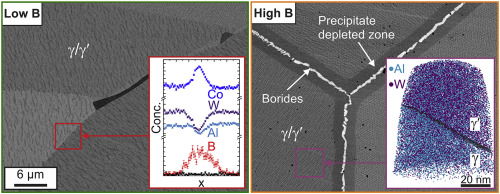当前位置:
X-MOL 学术
›
Acta Mater.
›
论文详情
Our official English website, www.x-mol.net, welcomes your
feedback! (Note: you will need to create a separate account there.)
On the grain boundary strengthening effect of boron in γ/γʹ Cobalt-base superalloys
Acta Materialia ( IF 8.3 ) Pub Date : 2018-02-01 , DOI: 10.1016/j.actamat.2017.12.020 M. Kolb , L.P. Freund , F. Fischer , I. Povstugar , S.K. Makineni , B. Gault , D. Raabe , J. Müller , E. Spiecker , S. Neumeier , M. Göken
Acta Materialia ( IF 8.3 ) Pub Date : 2018-02-01 , DOI: 10.1016/j.actamat.2017.12.020 M. Kolb , L.P. Freund , F. Fischer , I. Povstugar , S.K. Makineni , B. Gault , D. Raabe , J. Müller , E. Spiecker , S. Neumeier , M. Göken

|
Abstract Boron is an essential solute element for improving the grain boundary strength in several high temperature metallic alloys especially in Ni- and Co-base superalloys although the detailed strengthening mechanisms are still not well understood. In superalloys, boron leads to the formation of borides and precipitate depleted zones around the grain boundaries and alters the bond strength among the grains directly. In this paper, we explore in detail the role of the boron content in ternary γ/γ′ Co-9Al-9W alloys. Local as well as bulk mechanical properties were evaluated using nanoindentation and compression testing and correlated to near-atomic scale microstructure and compositions obtained from electron microscopy and atom probe tomography. The alloy variant with low B content (0.005 at.% B) reveals an increase in yield strength at room temperature and 600 °C and atom probe tomography investigations show that solute B segregates to the grain boundaries. However, in the bulk B exclusively partitions to the γ′ phase. Additionally, the γ′/γ′ grain boundaries are depleted in W and Al with the concentration locally shifted towards the γ composition forming a very thin γ layer at the γ′/γ′ grain boundaries, which supports dislocation mobility in the γ′/γ′ grain boundary region during deformation. Higher content of B (0.04 at.% B) promotes formation of W-rich borides at the grain boundaries that leads to undesirable precipitate depleted zones adjacent to these borides that decrease the strength of the alloy drastically. However, it was also found that a subsequent annealing heat treatment eliminates these detrimental zones by re-precipitating γ′ and thus elevating the strength of the alloy. This result shows that, if a precipitate depleted zone can be avoided, B significantly improves the mechanical properties of polycrystalline Co-base superalloys by strengthening the γ′ phase and by improving grain boundary cohesion.
中文翻译:

硼在γ/γʹ钴基高温合金中的晶界强化作用
摘要 硼是提高几种高温金属合金尤其是镍基和钴基高温合金晶界强度的重要溶质元素,尽管其详细的强化机制仍不清楚。在高温合金中,硼会导致在晶界周围形成硼化物和析出耗尽区,并直接改变晶粒之间的结合强度。在本文中,我们详细探讨了硼含量在三元 γ/γ' Co-9Al-9W 合金中的作用。使用纳米压痕和压缩测试评估局部和整体机械性能,并与从电子显微镜和原子探针断层扫描获得的近原子尺度微观结构和成分相关联。B 含量低(0.005 at. % B) 表明在室温和 600 °C 下屈服强度增加,原子探针断层扫描研究表明溶质 B 偏析到晶界。然而,在块体中 B 只分配到 γ' 相。此外,γ'/γ' 晶界缺乏 W 和 Al,浓度局部向 γ 成分移动,在 γ'/γ' 晶界形成非常薄的 γ 层,这支持 γ'/变形过程中的γ'晶界区域。较高的 B 含量(0.04 at.% B)会促进在晶界处形成富含 W 的硼化物,从而导致与这些硼化物相邻的不希望有的析出物耗尽区显着降低合金的强度。然而,还发现随后的退火热处理通过重新沉淀 γ' 消除了这些有害区域,从而提高了合金的强度。该结果表明,如果可以避免析出耗尽区,B 通过强化 γ' 相和提高晶界内聚力,显着改善多晶 Co 基高温合金的力学性能。
更新日期:2018-02-01
中文翻译:

硼在γ/γʹ钴基高温合金中的晶界强化作用
摘要 硼是提高几种高温金属合金尤其是镍基和钴基高温合金晶界强度的重要溶质元素,尽管其详细的强化机制仍不清楚。在高温合金中,硼会导致在晶界周围形成硼化物和析出耗尽区,并直接改变晶粒之间的结合强度。在本文中,我们详细探讨了硼含量在三元 γ/γ' Co-9Al-9W 合金中的作用。使用纳米压痕和压缩测试评估局部和整体机械性能,并与从电子显微镜和原子探针断层扫描获得的近原子尺度微观结构和成分相关联。B 含量低(0.005 at. % B) 表明在室温和 600 °C 下屈服强度增加,原子探针断层扫描研究表明溶质 B 偏析到晶界。然而,在块体中 B 只分配到 γ' 相。此外,γ'/γ' 晶界缺乏 W 和 Al,浓度局部向 γ 成分移动,在 γ'/γ' 晶界形成非常薄的 γ 层,这支持 γ'/变形过程中的γ'晶界区域。较高的 B 含量(0.04 at.% B)会促进在晶界处形成富含 W 的硼化物,从而导致与这些硼化物相邻的不希望有的析出物耗尽区显着降低合金的强度。然而,还发现随后的退火热处理通过重新沉淀 γ' 消除了这些有害区域,从而提高了合金的强度。该结果表明,如果可以避免析出耗尽区,B 通过强化 γ' 相和提高晶界内聚力,显着改善多晶 Co 基高温合金的力学性能。










































 京公网安备 11010802027423号
京公网安备 11010802027423号